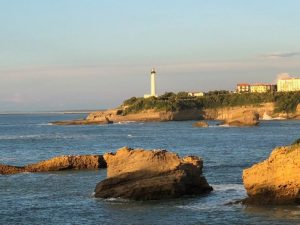Éminent symbole de la ville de Biarritz, le Phare entre dans la liste des lieux historiques et touristiques à ne manquer sous aucun prétexte. Érigé sur une falaise de près de 73 mètres d’altitude, le Phare s’élève lui-même à 47 mètres de hauteur (focale comprise). Dominant l’océan et son immensité, le Phare de Biarritz a traversé les âges depuis la Pointe Saint-Martin. Cet édifice est un majestueux témoignage du passé (et de l’avenir !) de la ville.
Les étapes qui ont jalonné l’histoire du Phare de Biarritz
Le phare de Biarritz est l’un des sites les plus emblématiques du Pays basque. Sa construction a commencé en 1830 et s’est achevée en 1834. Il a été imaginé par la commission du service des phares et balises en 1825.
Le phare de Biarritz est le premier phare français à avoir été construit avec une lentille de Fresnel. Ce type de lentille a été inventé par Augustin Fresnel en 1823 et permet d’obtenir un faisceau lumineux plus puissant.Il est possible d’y accéder en gravissant les 248 marches intérieures.
Également remarquable par son emplacement, le Phare est situé sur un rocher au bord d’une falaise surplombant l’Atlantique et plus précisément le Cap Hainsart. Le phare de Biarritz est donc l’un des plus puissants phares d’Europe avec une portée d’environ 50 km. L’intensité lumineuse est également très élevée puisqu’elle peut atteindre jusqu’à 1 million de candelas.
Le faisceau lumineux émis par le phare est visible même en journée. Il est donc une aide très puissante à la navigation. Il a permis le passage en toute sécurité de nombreux navires au fil des ans. C’est également une attraction touristique très populaire. En effet, le Phare l’un des sites les plus visités du Pays basque. Chaque année, des milliers de personnes viennent admirer le magnifique panorama offert par le site.
Cet édifice architectural est un monument important du patrimoine basque.
Le Phare de Biarritz : théâtre d’échanges politiques et diplomatiques en 2019
Emmanuel Macron avait élu le Phare de Biarritz pour recevoir les membres du G7 en 2019. Choisi en quelque sorte en « last minute » par le Président de la République, le site a accueilli le 24 août 2019 les chefs d’États ou premiers ministres du G7.
Ainsi, Donald Trump, Angela Merkel, Boris Johnson, Justin Trudeau, Giuseppe Conte, Shinzo Abe, et le président du Conseil Européen Donald Tusk se sont rencontrés avec Emmanuel Macron autour d’une table au pied du Phare de Biarritz.
Bien entendu, cette réunion entre chefs d’États fit l’objet d’un repas aux consonances basques… Et si l’on peut retenir une anecdote pour le moins amusante, les cuisines de l’Élysée avaient pour consigne à cette occasion, de ne sélectionner que des bouteilles de vin dont le prix n’excédait pas 25 €.
Évolutions du Phare de Biarritz depuis sa construction
Le Phare de Biarritz était originellement de forme octogonale. Puis, il fut agrandi en 1950 et pris une forme cylindrique. Cette modification importante coïncide avec l’électrification de l’édifice.
Le Phare de Biarritz fut automatisé en 1980. À la différence du Phare de Nividic (à l’ouest de Ouessant) qui lui fut construit en 1936, et connut dès ses débuts une automatisation totale. Il était finalement question, dans le cas du Phare de Biarritz, de se dispenser de gardiens grâce à une gestion automatique et des commandes à distance.
Ce monument de la ville de Biarritz est inscrit depuis 2009 à la liste des monuments historiques.
Enfin, les dernières modifications apportées au Phare de Biarritz, eurent lieu en 2020. Elles eurent pour but de restaurer la salle de la lanterne, et d’installer des baies en verre pour éradiquer les infiltrations d’humidité à travers les anciennes baies en plexiglas.
Détails du Phare de Biarritz
La salle de la lanterne est entourée d’une frise remarquable. Nous ne saurions dire si cette frise est inspirée du courant Art Déco (que l’on rencontre à de nombreux endroits dans la ville de Biarritz), mais on y observe une représentation simple et délicate de vagues.
En outre, douze gargouilles, des têtes de lion en bronze, ornent le dôme de cuivre du Phare.





